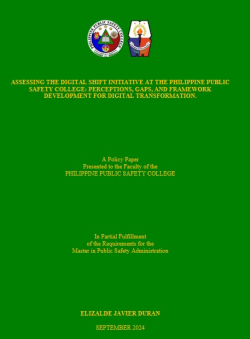PUBLIC SAFETY AND SECURITY STUDY OF OLONGAPO CITY

Type
Thesis
Authors
PCPT PABLO G AGGABAO ( PCPT ROY S CABRERA PCPT CARLO B DUYAO )
Category
PSOAC
[ Browse Items ]
Publication Year
2024
Abstract
EXECUTIVE SUMMARY
This study entitled “Enhancing Road Safety in Olongapo City: An Analysis of Contributing Factors, Accident-Prone Areas, and Public Safety Initiatives” examines the factors contributing to road accidents in Olongapo City, focusing on enhancing public safety and security. By analyzing data from the traffic enforcement agencies/offices in Olongapo City and from concerned offices of the Local government Unit (LGU) of the city and reviewing supporting literature, the research aims to evaluate the road safety initiatives of the traffic enforcement agencies and LGU of Olongapo City, identify the accident-prone areas in the city and key causes of road accidents. The ultimate goal is to provide actionable recommendations and a comprehensive action plan to reduce accident rates and improve road safety in Olongapo City.
The primary research questions addressed in this study are: (1) What are the primary causes of road/vehicular accidents from January 1, 2023 to May 3, 2024 and what are the identified accident-prone areas in Olongapo City? (2) How effective are current traffic management and enforcement measures in reducing road/vehicular accidents in Olongapo City? (3) What measures can be implemented to effectively reduce the incidence of road/vehicular accidents and improve safety in Olongapo City?
This executive summary highlights the essential findings and recommendations regarding road safety in Olongapo City, focusing on January 1, 2024 to May 31, 2024. (1) During this period, road traffic accidents in Olongapo City were predominantly caused by human factors such as speeding, distracted driving, under the influence, and non-compliance with traffic laws. Secondarily, environmental conditions and infrastructure issues such as sharp curves, steep slopes, narrow lanes, inadequate street lightning, and insufficient warning signs are another cause of road accident in which it greatly affects the driver’s ability or skills. Another factor are vehicle maintenance issues and challenges associated with urbanization also play significant roles. These issues contributed significantly to accidents across several identified accident-prone areas, including segments of the National highway in Libas, Cabalan, Kalaklan, and Barretto, and intersections such as Kalaklan Stoplight and Rizal Avenue adjacent to SM Central. Each area presented distinct challenges, from high-speed risks and merging lanes to visibility concerns and inadequate traffic management. (2) Current traffic management measures in Olongapo City have effectively deployed police and traffic enforcers to enforce traffic laws and regulate traffic flow and conduct regular road safety and defensive driving seminars. Likewise, the city government together with the DPWH conduct regular road safety initiatives like road construction and maintenance, road markings and repainting, installation of warning signs and tree trimming. However, challenges persist, particularly in maintaining consistent enforcement during off-peak hours and addressing infrastructure deficiencies promptly. (3) Proactive measures are recommended to enhance road safety. These include infrastructure improvements such as road widening, additional street lighting installations, and enhanced traffic signages to improve visibility and guide motorists effectively. Strengthening traffic management by increasing the presence of traffic enforcers and leveraging technology for real-time monitoring can further mitigate accident risks. Public awareness campaigns aimed at educating drivers on defensive driving techniques and road etiquette will promote safer driving practices. Additionally, establishing a proactive maintenance schedule for road repairs and infrastructure upkeep will ensure sustained improvements in road safety. The study concludes that addressing risky driver behaviors, improving road conditions, ensuring regular vehicle maintenance, and implementing targeted interventions for young male drivers are critical to reducing road accidents in Olongapo City. Enhanced traffic enforcement and public awareness campaigns are essential to changing driver behaviors and improving road safety. The findings underscore the importance of a multifaceted approach that combines education, and infrastructure improvements to create a safe driving environment.
Several recommendations are proposed to address the identified issues. First, increase traffic enforcement by deploying more traffic enforcers during high-risk times and areas, utilizing speed cameras and DUI checkpoints, and enhancing the visibility of law enforcement. Second, prioritize regular road maintenance, repair potholes, improve signages and warning devices, and enhance street lighting particularly in accident-prone areas. Third, implement targeted educational programs in schools and universities focusing on the dangers of risky driving behaviors, and use social media campaigns to reach young male drivers. Fourth, encourage regular vehicle inspections and maintenance through public campaigns and incentives. Finally, conduct continuous public awareness campaigns using various media channels to promote safe driving practices and highlight the consequences of risky behaviors.
The action plan to enhance road safety in Olongapo City includes several key steps. First, increase night-time patrol shifts by addressing current patrol deployment, identifying high-risk areas, developing new patrol schedules, and recruiting additional traffic enforcers. Second, mobile units equipped with speed detection and alcohol testing devices should be deployed in high-risk areas during night-time. Third, leverage technology for real-time monitoring and enforcement system, and setting up a central monitoring center. Fourth, engage with the community and raise awareness campaigns, meeting with community leaders and local businesses, and distributing informational materials. Finally, key performance indicators (KPIs) will be established to measure the effectiveness of the night-time traffic enforcement measures, conduct regular reviews, and adjust strategies based on the findings. This comprehensive action plan aims to address the identified issues, enhance road safety, and reduce the incidence of rad accidents in Olongapo City. By implementing these measures, the city can create a safer driving environment and protect the well-being of its residents.
This study entitled “Enhancing Road Safety in Olongapo City: An Analysis of Contributing Factors, Accident-Prone Areas, and Public Safety Initiatives” examines the factors contributing to road accidents in Olongapo City, focusing on enhancing public safety and security. By analyzing data from the traffic enforcement agencies/offices in Olongapo City and from concerned offices of the Local government Unit (LGU) of the city and reviewing supporting literature, the research aims to evaluate the road safety initiatives of the traffic enforcement agencies and LGU of Olongapo City, identify the accident-prone areas in the city and key causes of road accidents. The ultimate goal is to provide actionable recommendations and a comprehensive action plan to reduce accident rates and improve road safety in Olongapo City.
The primary research questions addressed in this study are: (1) What are the primary causes of road/vehicular accidents from January 1, 2023 to May 3, 2024 and what are the identified accident-prone areas in Olongapo City? (2) How effective are current traffic management and enforcement measures in reducing road/vehicular accidents in Olongapo City? (3) What measures can be implemented to effectively reduce the incidence of road/vehicular accidents and improve safety in Olongapo City?
This executive summary highlights the essential findings and recommendations regarding road safety in Olongapo City, focusing on January 1, 2024 to May 31, 2024. (1) During this period, road traffic accidents in Olongapo City were predominantly caused by human factors such as speeding, distracted driving, under the influence, and non-compliance with traffic laws. Secondarily, environmental conditions and infrastructure issues such as sharp curves, steep slopes, narrow lanes, inadequate street lightning, and insufficient warning signs are another cause of road accident in which it greatly affects the driver’s ability or skills. Another factor are vehicle maintenance issues and challenges associated with urbanization also play significant roles. These issues contributed significantly to accidents across several identified accident-prone areas, including segments of the National highway in Libas, Cabalan, Kalaklan, and Barretto, and intersections such as Kalaklan Stoplight and Rizal Avenue adjacent to SM Central. Each area presented distinct challenges, from high-speed risks and merging lanes to visibility concerns and inadequate traffic management. (2) Current traffic management measures in Olongapo City have effectively deployed police and traffic enforcers to enforce traffic laws and regulate traffic flow and conduct regular road safety and defensive driving seminars. Likewise, the city government together with the DPWH conduct regular road safety initiatives like road construction and maintenance, road markings and repainting, installation of warning signs and tree trimming. However, challenges persist, particularly in maintaining consistent enforcement during off-peak hours and addressing infrastructure deficiencies promptly. (3) Proactive measures are recommended to enhance road safety. These include infrastructure improvements such as road widening, additional street lighting installations, and enhanced traffic signages to improve visibility and guide motorists effectively. Strengthening traffic management by increasing the presence of traffic enforcers and leveraging technology for real-time monitoring can further mitigate accident risks. Public awareness campaigns aimed at educating drivers on defensive driving techniques and road etiquette will promote safer driving practices. Additionally, establishing a proactive maintenance schedule for road repairs and infrastructure upkeep will ensure sustained improvements in road safety. The study concludes that addressing risky driver behaviors, improving road conditions, ensuring regular vehicle maintenance, and implementing targeted interventions for young male drivers are critical to reducing road accidents in Olongapo City. Enhanced traffic enforcement and public awareness campaigns are essential to changing driver behaviors and improving road safety. The findings underscore the importance of a multifaceted approach that combines education, and infrastructure improvements to create a safe driving environment.
Several recommendations are proposed to address the identified issues. First, increase traffic enforcement by deploying more traffic enforcers during high-risk times and areas, utilizing speed cameras and DUI checkpoints, and enhancing the visibility of law enforcement. Second, prioritize regular road maintenance, repair potholes, improve signages and warning devices, and enhance street lighting particularly in accident-prone areas. Third, implement targeted educational programs in schools and universities focusing on the dangers of risky driving behaviors, and use social media campaigns to reach young male drivers. Fourth, encourage regular vehicle inspections and maintenance through public campaigns and incentives. Finally, conduct continuous public awareness campaigns using various media channels to promote safe driving practices and highlight the consequences of risky behaviors.
The action plan to enhance road safety in Olongapo City includes several key steps. First, increase night-time patrol shifts by addressing current patrol deployment, identifying high-risk areas, developing new patrol schedules, and recruiting additional traffic enforcers. Second, mobile units equipped with speed detection and alcohol testing devices should be deployed in high-risk areas during night-time. Third, leverage technology for real-time monitoring and enforcement system, and setting up a central monitoring center. Fourth, engage with the community and raise awareness campaigns, meeting with community leaders and local businesses, and distributing informational materials. Finally, key performance indicators (KPIs) will be established to measure the effectiveness of the night-time traffic enforcement measures, conduct regular reviews, and adjust strategies based on the findings. This comprehensive action plan aims to address the identified issues, enhance road safety, and reduce the incidence of rad accidents in Olongapo City. By implementing these measures, the city can create a safer driving environment and protect the well-being of its residents.
Number of Copies
1
| Library | Accession No | Call No | Copy No | Edition | Location | Availability |
|---|---|---|---|---|---|---|
| NPC Library | 676793 | 1 | Yes |




